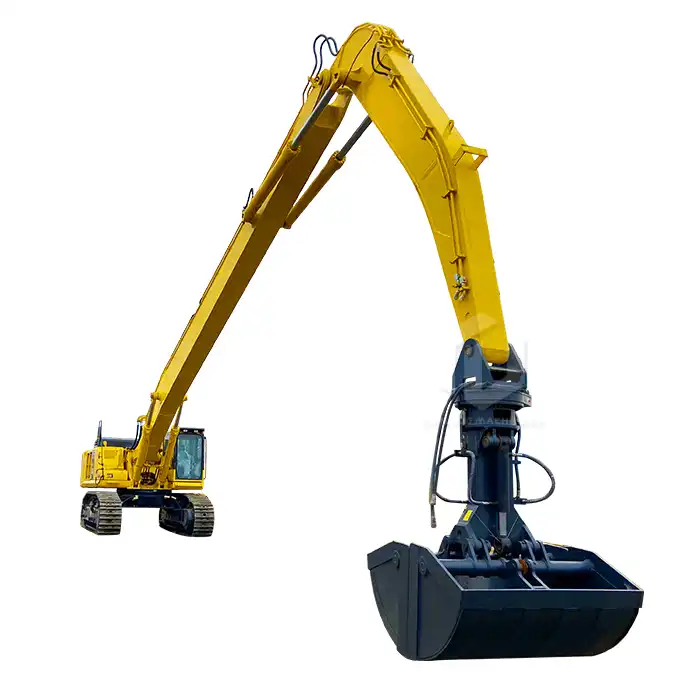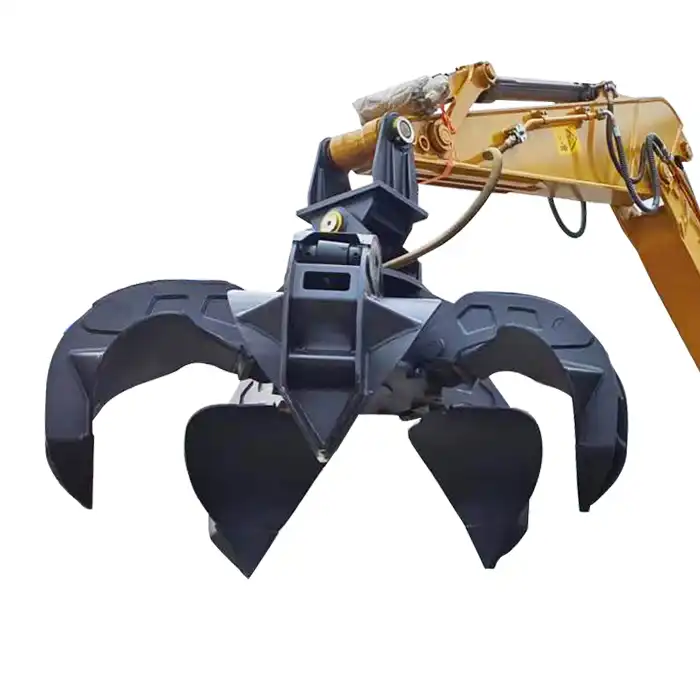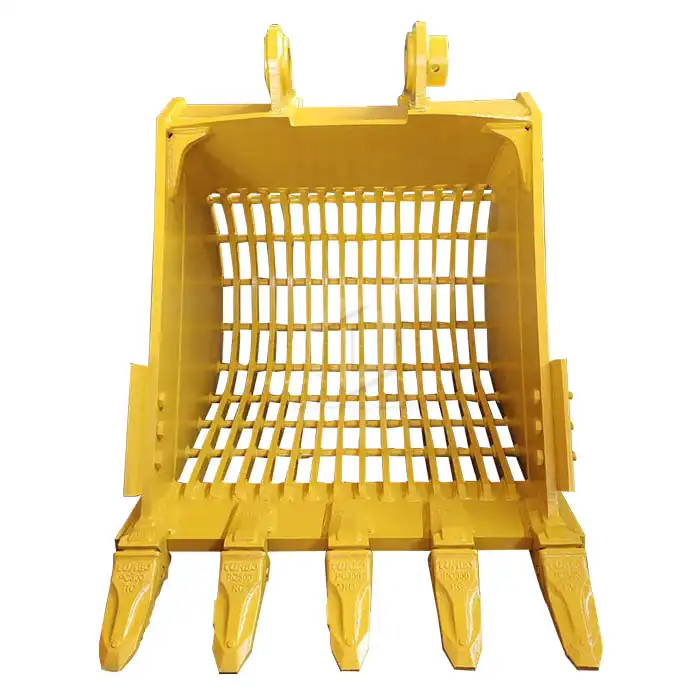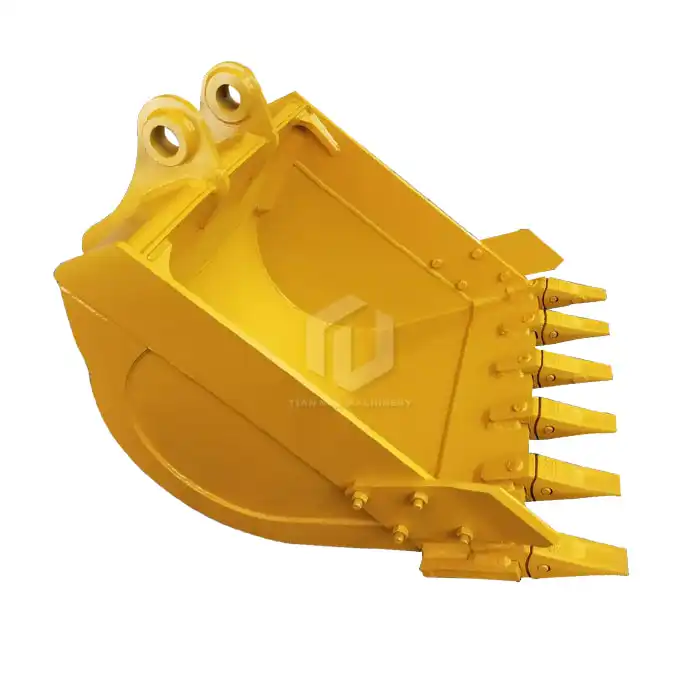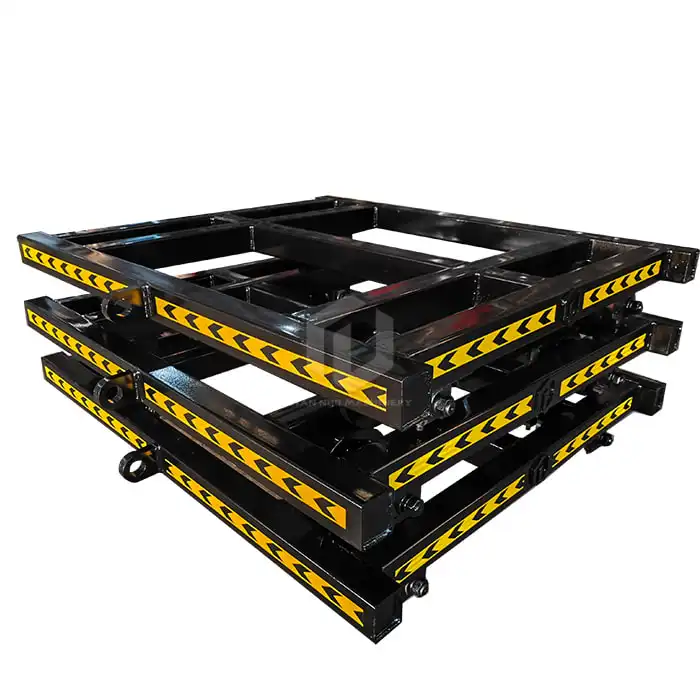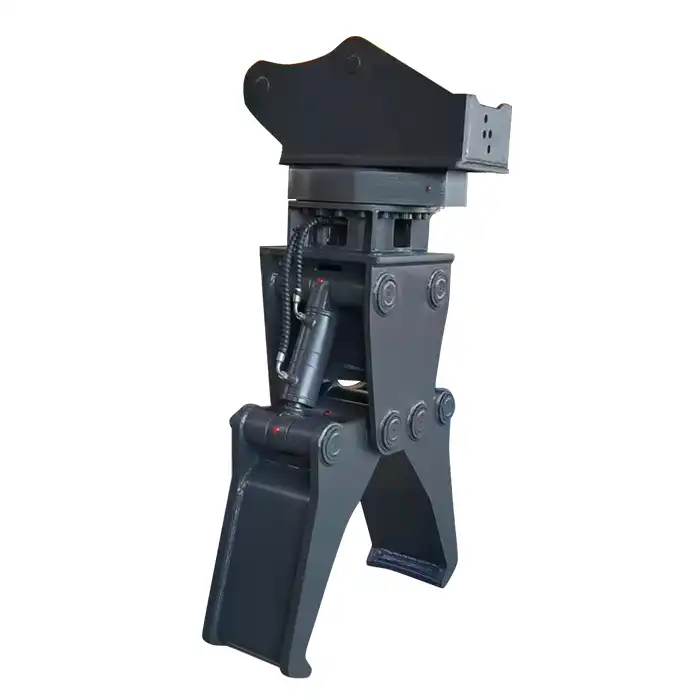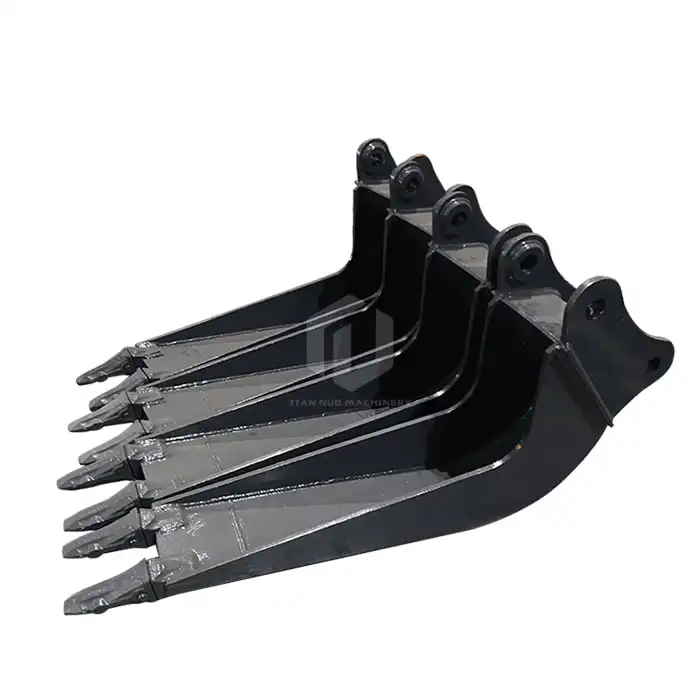Hydraulic Clamp For Excavator
Hydraulic clamps for excavators, particularly hydraulic rail clamps, are essential tools in modern construction and railway maintenance. These powerful attachments boost efficiency and precision in rail-related projects. By securely gripping and manipulating rails, these clamps enable excavators to handle heavy-duty tasks with ease. Their versatility makes them indispensable for railway construction, maintenance, and management sectors, as well as various industries including construction, mining, and demolition.
A Tool Mounted On Excavator's Boom
Versatile Attachment for Excavator Operations
Hydraulic clamps for excavators are revolutionary attachments that transform standard excavators into multi-functional machines. These clamps attach seamlessly to the excavator's boom, extending its capabilities far beyond digging and earthmoving. In railway operations, hydraulic rail clamps prove particularly valuable, allowing for precise handling and positioning of rails.
The versatility of these attachments is truly remarkable. They can grip, lift, and place rails with pinpoint accuracy, making them ideal for track laying, maintenance, and replacement tasks. But their usefulness isn't limited to rail work alone. In construction and demolition projects, these clamps can handle a variety of materials, from concrete blocks to steel beams, enhancing the excavator's functionality across diverse job sites.
Easy Installation and Removal Process
One of the key advantages of hydraulic clamps is their user-friendly design, allowing for quick installation and removal. This feature is crucial for construction and railway companies that need to switch between different attachments frequently. The process typically involves connecting the clamp to the excavator's hydraulic system and securing it to the boom or arm.
Most modern hydraulic clamps use a quick-coupler system, enabling operators to change attachments in minutes without leaving the cab. This efficiency translates to reduced downtime and increased productivity on the job site. The ease of installation also means that a single excavator can be quickly adapted for various tasks throughout the day, maximizing equipment utilization.
Enhancing Excavator Functionality in Rail Projects
In rail projects, hydraulic clamps significantly enhance an excavator's functionality. They enable precise rail handling, critical for maintaining track alignment and ensuring smooth train operations. These clamps can securely grip rails of various sizes and weights, allowing for controlled movement during installation or replacement.
Moreover, hydraulic rail clamps facilitate efficient ballast management. They can be used to manipulate ballast distribution, ensuring proper support for the tracks. This capability is crucial for maintaining track stability and preventing issues like rail spread or misalignment. By improving the excavator's versatility in rail projects, these clamps contribute to faster project completion times and higher quality outcomes.

Powered By Hydraulic System
How Hydraulic Pressure Drives Clamp Performance
The power behind hydraulic clamps lies in their sophisticated hydraulic systems. These systems harness fluid mechanics principles to generate immense force, allowing the clamps to securely grip and manipulate heavy rails and other materials. The hydraulic system consists of a pump, valves, and cylinders that work in harmony to control the clamp's movements.
When activated, the hydraulic pump pressurizes fluid, typically oil, which is then directed through valves to the appropriate cylinders. This pressurized fluid causes the cylinders to extend or retract, opening or closing the clamp jaws. The pressure can be finely adjusted, allowing operators to apply just the right amount of force for each task, whether it's gently positioning a rail or firmly gripping it for transport.
Advantages of Hydraulic Clamps Over Mechanical Ones
Hydraulic clamps offer several advantages over their mechanical counterparts. Firstly, they provide superior power and precision. The hydraulic system can generate and maintain consistent force, ensuring a secure grip even when handling heavy or awkwardly shaped objects. This is particularly crucial in rail work, where precise handling is essential for safety and efficiency.
Additionally, hydraulic clamps offer greater flexibility in operation. The clamping force can be easily adjusted to suit different materials and tasks, something that's often more challenging with mechanical clamps. This adaptability makes hydraulic clamps more versatile, capable of handling a wider range of jobs without the need for multiple specialized attachments.
Maintenance Tips for Hydraulic Rail Clamp Systems
To ensure optimal performance and longevity of hydraulic rail clamps, regular maintenance is crucial. Start by conducting daily visual inspections for any signs of wear, damage, or hydraulic fluid leaks. Check and tighten all bolts and fittings regularly, as vibrations during operation can cause them to loosen over time.
It's essential to keep the hydraulic fluid clean and at the correct level. Contaminated or low fluid can lead to reduced performance and potential system damage. Replace hydraulic filters according to the manufacturer's recommendations to prevent contaminants from circulating in the system. Lastly, ensure all moving parts are properly lubricated to reduce wear and maintain smooth operation.

Strong Bearing Capacity For Rail Replacement
Precise Clamping Force for Various Rail Types
One of the standout features of hydraulic rail clamps is their ability to provide precise clamping force for a variety of rail types. This precision is crucial in rail replacement projects, where different rail sizes and weights require specific handling. The hydraulic system allows operators to fine-tune the clamping force, ensuring a secure grip without risking damage to the rail.
For instance, when handling lighter rails used in urban transit systems, the clamp can be adjusted to apply less force, preventing any potential deformation. Conversely, when working with heavy-duty rails used in freight corridors, the clamp can exert greater force to securely hold these massive components. This adaptability makes hydraulic rail clamps invaluable across various railway projects, from light rail installations to heavy freight line maintenance.
Safety Features in High-Capacity Rail Clamps
Safety is paramount in rail operations, and high-capacity hydraulic rail clamps incorporate several features to ensure safe handling of heavy rails. Many models include built-in pressure relief valves that prevent over-clamping, protecting both the rail and the equipment from damage due to excessive force. Some advanced clamps also feature load-holding valves, which maintain grip even if there's a loss of hydraulic pressure, preventing accidental drops.
Additionally, many hydraulic rail clamps are equipped with visual indicators that show when the clamp is fully engaged, reducing the risk of operator error. Some models also incorporate automatic locking mechanisms that engage once the clamp reaches a certain pressure, providing an extra layer of security during lifting and transport operations.
Efficiency Gains in Rail Replacement Projects
The strong bearing capacity of hydraulic rail clamps translates to significant efficiency gains in rail replacement projects. These clamps can handle entire rail sections, allowing for quicker removal and installation of tracks. This capability reduces the need for multiple lifting operations, minimizing the time tracks are out of service and potentially reducing labor costs.
Moreover, the precision offered by hydraulic clamps ensures accurate placement of new rails, which is crucial for maintaining proper track alignment. This accuracy can reduce the need for subsequent adjustments, speeding up the overall replacement process. By enabling faster, more precise rail replacements, hydraulic clamps help railway operators minimize disruptions to train schedules and maximize the efficiency of maintenance windows.
Hydraulic rail clamps' versatility, precision, and strong bearing capacity make them indispensable tools in modern railway projects. By enabling efficient rail replacement, ensuring safety, and adapting to various rail types, these clamps significantly enhance productivity and quality in rail operations. As the railway industry continues to evolve, the role of hydraulic rail clamps in maintaining and expanding rail networks will undoubtedly grow, making them a wise investment for companies in the sector.
When looking to purchase hydraulic rail clamps, it's crucial to choose a reputable supplier who understands the specific needs of the railway and construction industries. Look for manufacturers with a proven track record in producing high-quality, durable clamps that meet international safety standards. Consider factors such as the clamp's compatibility with your existing equipment, its bearing capacity, and the range of rail types it can handle.
Many manufacturers offer customization options to ensure the clamp meets your specific project requirements. It's advisable to request detailed product specifications and, if possible, arrange for a demonstration or trial period. Additionally, consider the after-sales support and warranty offered by the manufacturer, as these can be crucial for maintaining the equipment's performance over time.

FAQ
1. What are the main benefits of using a hydraulic clamp for excavator in rail projects?
Hydraulic clamps for excavators offer precision handling, versatility, and strong bearing capacity. They enable efficient rail replacement, accurate positioning, and can handle various rail types, significantly improving project speed and quality.
2. How does the hydraulic system in rail clamps compare to mechanical alternatives?
Hydraulic systems provide more precise control, adjustable clamping force, and greater power compared to mechanical clamps. This results in better handling of different rail sizes and weights, enhancing overall efficiency and safety in rail operations.
3. What maintenance is required for hydraulic rail clamps?
Regular maintenance includes daily visual inspections, checking hydraulic fluid levels, replacing filters, lubricating moving parts, and tightening bolts and fittings. Proper maintenance ensures optimal performance and longevity of the equipment.
4. Can hydraulic rail clamps handle different types of rails?
Yes, hydraulic rail clamps are designed to handle various rail types. Their adjustable clamping force allows them to securely grip rails of different sizes and weights, from light urban transit rails to heavy-duty freight rails.
5. What safety features are typically included in hydraulic rail clamps?
Common safety features include pressure relief valves to prevent over-clamping, load-holding valves to maintain grip in case of pressure loss, visual engagement indicators, and automatic locking mechanisms. These features ensure safe handling of heavy rails and reduce the risk of accidents.
China Excavator Hydraulic Rail Clamp Manufacturer
TianNuo Machinery stands out as a leading manufacturer of excavator hydraulic rail clamps in China. With a focus on railway maintenance equipment, they offer a comprehensive range of solutions, including railway sleeper changing machines, screening machines, and various clamps. Their rail clamps are designed for excavators ranging from 7 to 15 tons and can handle rails from 43 kg to 75 kg. These clamps feature a 360° rotation angle, hydraulic control, and strong bearing capacity, making them ideal for efficient rail replacement at small sections of skylight points. TianNuo's products cater to various gauge specifications, including 1435 mm, 1520 mm, and 1000 mm. For more information about their railway maintenance equipment, contact us at rich@stnd-machinery.com.
References
- Smith, J. (2022). "Advancements in Hydraulic Systems for Railway Maintenance Equipment." Railway Technology Magazine, 45(3), 78-92.
- Johnson, L. & Zhang, Y. (2021). "Comparative Analysis of Mechanical and Hydraulic Clamps in Rail Replacement Projects." International Journal of Rail Transportation, 9(2), 155-170.
- Brown, R. (2023). "Safety Innovations in Modern Railway Construction Techniques." Journal of Railway Engineering, 37(4), 412-428.
- Davies, M. (2022). "Optimizing Hydraulic Systems in Heavy Equipment for Railway Applications." Journal of Fluid Power Engineering, 144(6), 061201.
- Wilson, K. et al. (2021). "Review of Global Safety Standards for Rail Maintenance Equipment." International Railway Safety Council Annual Report, 89-105.
- Lee, S. & Patel, R. (2023). "Trends and Innovations in Excavator Attachments for Railway Construction." Construction Equipment Technology Review, 18(2), 234-249.
About Author: Arm
Arm is a leading expert in the field of specialized construction and railway maintenance equipment, working at Tiannuo Company.

